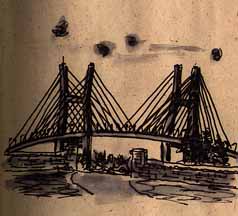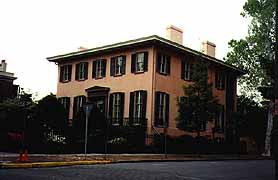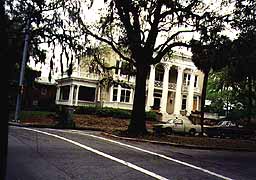American Sabbatical 75: 3/21/97
Savannah
3/20.. Georgia on our minds.
We were aiming for the southern giant, but kept hitting "just one more" little
plantation. The rivers of South Carolina were lined with the critters,
then and now. Some of us were eager to take a shot, others of
us felt like our ass was in a sling.
(Memo #67)
March 20 Drayton Hall
Who? 7 generations of the Drayton family
What? family’s country seat
Where? 9 miles northwest from Charleston on the Ashley River
When? built in 1670
How? materials imported from Europe and locally made
Topics: restorations v. reconstructions v. recreations v. preservations
Questions: What is the best way to represent the past?
Drayton Hall is a Georgian palladian mansion on the Ashley River.
To be "Georgian" , our guide explained, a building has to be "big,
bold, and balanced", "palladian" refers to Greek and Roman elements
such as porticoes and columns. Drayton Hall is the largest and
most imposing of the plantation houses we’ve visited. It looms
four stories tall from the flats by the river, symmetrical brick,
rather stark with white classical trim. The main floor is reached
by a grand staircase which gives it elevation.
Drayton Hall is billed as the only rice plantation house on the
Ashley River left intact after the Civil War. Family legend says
it was spared the looting and destruction others suffered because
the inventive owners flew a flag indicating (falsely) that it
was being used as a smallpox hospital. Water damage is blamed
on the fact that the original roof was sealed with lead which
was removed to provide bullets for the Confederacy. It was never
modernized. It is also entirely empty.
Drayton Hall is a PRESERVATION not a reconstruction. The historic
trust which owns Drayton Hall did not attempt to refurnish or
refurbish the old building but to stabilize and maintain it. The
huge echoing rooms and damaged trim are poignant and impressive.
The outbuildings are gone, the garden is wild. Did the directors
revolt against the cloying prettiness of the restored great houses
of the South? In Virginia and North Carolina and South Carolina
I’ve been in gorgeous colonial homes where the guides carefully
tell you that the owners (many still living, often on site) bought
furniture "of the period", the room "was probably like". They
tell you the age and style and worth of the great cabinetry pieces.
The furnishings are a tribute to the taste for antiques and care
of the modern owners, not accurate portrayals of the house’s colonial
or early federal life.
The most extreme example of historical overlay was the Kaminski
House in Georgetown, S.C. where the guide spent twenty minutes
telling us how the Kaminskis (who bought it in the late 1940’s
and live there until their deaths, also detailed by the guide)
renovated and changed it - the original encircling verandas have
disappeared except on the front to become bathrooms and bedrooms
and kitchen. Twentieth century Kaminski portraits deck the walls
and one room is furnished in twentieth century masculine study.
In a continuously inhabited house the problem remains: what era
do you freeze? 1740’s? 1830’s? It is easiest when a house had
one famous owner (Mt. Vernon, for example) or an important diary
describing it. In the now privately owned homes, where do the
owners live? At Berkeley Plantation in Virginia, the current elderly
owner lives upstairs (which is off-limits), at Hopsewee near Georgetown
the lovely owners showed me through their entire home (which seems
weird, they sit around and wait for the visitors’ bell and clean
up carefully every morning). Only one room in the basement is
off limits).
Drayton Hall dates to 1670 and housed seven generations of the
Drayton family (the last Drayton owner died in 1969). The family
was hugely wealthy, the first John Drayton owned 30 different
properties with 650 acres here. Drayton Hall was built to impress
(it even had a separate seven hole outhouse). It has 15 rooms
and 13 fireplaces. It was made of red sandstone imported from
Wales, Portland limestone from England, local bricks and wood.
Its glories are the intricately carved overmantles, the elaborate
handcarved mahogany “swags” over the windows in the withdrawing
room, the molded plaster ceiling in the great hall, and the 27
foot high ceiling in the great staircase (intentionally higher
than any other building in the colony!). The veranda under the
first floor portico has checkerboard inlaid stone and is reached
by a double staircase with wrought iron railings. The house’s
brickwork is elaborately laid in a Flemish bond design.
The absent furniture went in one pretty fascinating incident.
Rebecca Parry was 16 when she became the fourth (I think) wife
of one of the John Draytons. He was 59. They had several children.
When he died, her stepson became the owner of the plantation.
She agreed to move out, but took the family furniture and, when
she died, her will had the furniture auctioned off and the money
used to provide a living for the Drayton slaves (she could not
free them). I wish I knew more about her.
I walked across the lawn and through the now wild gardens to the
river edge. A large greenhouse stood off to one side where the
family raised a variety of plants. They experimented, trying pomegranates
(a success) and olives (a failure).
Drayton Hall has the scale and “feel” of a great English manor
house. It is far grander than the other plantations I’ve seen
even in its current derelict state.
3/20.. cont.
Peggy took pity on my current derelict state, decided not to tour the other 600
plantations up this river, and we cut south across Charleston’s
outer suburbs, racing the musclecars for the Georgia line. Is
it my imagination, or are there more stockracing wannabes down
here on the sultry flats? Maybe the arrow-straight two-lanes slotted
between a seamless sameness makes you want to tromp on it hard,
and blow by the nodding tourists. Wooh. The only roadside attractions
down here seem to be FIREWORKS and BOILED PEANUTS. Maybe we’ve
got the wrong attitude. We should be chomping on nuts and tossing
bottlerockets out the windows.
We’ve been trying to find sideroads, but in the great pine plantation
all the arteries are straight ahead and full tilt. We opted for
a diversion to Beaufort, hoping the inlets and islands would break
up the monotony and slow the pace. We didn’t know the Marines
had landed here, too, and the hard charging traffic was all stiffbacked
and shave-headed. Although the retired NCOs were sporting bumper
stickers reading "The Worst Day Fishing Is Better Than The Best
Day Working," which is almost subversive, I’d think.
Capt. Ken had recommended us to Beaufort as a good town to drop
anchor in, but when we got to downtown it was all torn up for
a new sewage system, and the main street was a bit too contractor
quaint for strolling. It took us a while to decode our guidebook
and find motel alley, and we checked into another budget bedding
outlet. To the navigator’s disgust, the pool wasn’t open yet here
either. Here it is temperatures in the 70’s, and they haven't
scrubbed and chlorinated the pools yet?
This might be a good time to observe that New Delhi U. must be
specializing in motel management, because East Indians have taken
over lowrent lodging franchises all over the US, but particularly
in the Southwest and Southeast. Invariably the service at the
economy flops has a colonial accent, and, I hate to say, a bit
of an attitude. Maybe it's a reaction to the long tradition of
caste, but you sense that service is a trifle beneath these managers.
The rooms usually have something awry.. dead bulbs, plumbing malfunctions,
sticky this and jamming that.. and when you report the problem,
the response has a shrug in it. And the housekeeping crews are
always black. Does this tell us anything?
After we’d cooled our heels for a spell, we took a second look
at Beaufort, and found out why the Captain liked it so much. The
back streets are beautiful, and look like real people live in
them.. could even afford to. The glories of flower and leaf are
in full frenzy here, too, the houses spaced out among spreading
trees draped in moss, and folks on the verandas with tall cool
ones, or walking the streetsides in the dusk. We stood back to
back and drew two romantic evensongs as the colors faded. A state
trooper was sitting on the porch of mine, and he waved.
Then our juices were gurgling, and we read menus around downtown,
deciding on The Bank, where we ate next to the old tellers’ cages.
Simple fare, artfully presented, reasonably priced, ultimately
forgettable. Out post-prandial along the waterfront, between the
boat basin and the island bridge convinced us that the burghers
of Beaufort had put pedestrian amenities above the almighty auto,
and this WAS a town worth dropping your hook in. Even the moon
poked out of the clouds for a moment or two. We drove back to
our sub-continent contented.
3/21.. Savannah.
The Friday follies began with a simple search for bread. Fresh bread. Bakery bread. Nobody
in Beaufort had heard of such a thing, and the alternate forage
I came up with at Piggly-Wiggly was for a porcine palate. Surprising
to think that we’ve been spoiled by Hannaford Bros. Maybe that’s
why they are expanding southward so rapidly. We saw their stores
in North Carolina, but not in Beaufort, sad to say.
We were sidling toward sophisticated Savannah anyhow, so we made
do with cereal and oranges, and passed up the boiled peanuts.
Peggy seems to have cured her intestinal malaise, incidentally,
by avoiding nuts and berries and all the other stuff that has
seeds and sharp edges. Some days we had been subsisting on mixed
seeds and nuts out west, and she’d been a hurting lady.. ipso
facto. So much for becoming seedeaters.
The big veg kept getting deeper as we went south. Thicker undergrowth,
more leafing out, ranker grasses by the road. In places the flora
was winning over old asphalt, and dilapidated cinderblock filling
stations overgrown with wisteria now housed all manner of activities:
total immersion churches, fireworks marts, and domiciles with
spare parking. With our windows down, crosswinds rattled the loose
litter in back, gusts of estuarial essence whirled round us as
we rose over the backwater causeways, the V-winged buzzards lofted
and gyred. A 4X4 Chevy shortbed jacked up on oversized mudrunners
came buzzing by us with a jack staff mounted in the bed and a
big Confed flag snapping in the slipstream. Good Old Boys with
peachy plates pushing the limit in their assault vehicle.
Then, after another interminable stretch of hypnoroad, a great
steel synapse rose up out of the flats. Two towering Hs of pale
gray with massive guying cables of white fanning down to the suspended
deck like the outlines of nested teepees, or immense As. A totally
modern suspension design: The HAHA Bridge. (After much public
debate Georgians are calling it the Talmadge Bridge.) We chortled
up and over with our mouths agape.

HAHA Bridge
Into Savannah, another city of considerable charm, but an entirely different feel from Charleston. Savannah was laid out to an enlightened plan, with pocket parks every few blocks in a rectilinear grid. What it loses in organic variety, the city gains in planned green space. Here, too, the flowers are in riot, and nobody's making arrests.

Savannah Manse
We pulled into the old brick train terminal and warehouse quad,
now the visitors’ center and school of art and design, with a
wideangle view of the HAHA and a lot full of trolleys and tour
busses. Like all of downtown there’s more open sky shining here,
less sense of protective enclosure than in the twined alleyways
of Charleston, and more traces of demolition renewal.. gaps in
the smile. Savannah hasn’t suffered from an excess of architectural
protection.
We sauntered about the historic district afoot and on Owl-wing,
looking for fresh bread. It’s remarkable how our staff of life
has been downsized in the South to an incidental side dish.. this
is a corn economy vs. wheat. The horse cabbies pointed us where
to loaf, and we leisured our way into a cafe selling seasoned
flat breads and crusty baguettes. We captured one each, and enjoyed
the unhurried hubbub of the downtown midday.
We then corkscrewed ourselves from square to square and around
and around gawping at the ornate facades and elegant piles. What
highrise buildings there are don’t impinge on the sense of low
buildings and open sky. This downtown is a thorough mix of residential
and commercial, with old world elegance next to utilitarian dowdy,
parts houses caddycorner to endowed museums, painstaking restorations
alongside rubbled lots. In that sense Savanna is truly alive,
but the integral illusion of an elder place has gone missing.
Some of the missing are hanging out in the parks, too, bringing
that vague disquiet the raffish unemployed bring to a neighborhood.
Charleston has weeded the seedy types out of the tourist paths,
while Savannah is totally lived in.
Our next mission was to find AAA and stock up on large scale maps
of the states in our future, and it was an exercise in modernization.
Moving out from the city center, we encountered more tree-shaded
parks in less elegant neighborhoods, then more traffic in increasing
malldom. The modern American inevitability. Add autos and the
urge to burb, hey presto: strip uglies. But somewhere in the last
few days I had a moment of truth in one of these Anywherevilles:
THIS is America. Not the quaint survivals of our mythic heritage,
but the familiar sameness of autodom.

And another
Margaret Mead said that the franchise ambiance was a unifying
force in our culture. Peoples from all over the world could come
together in this country, and get the same Big Mac anywhere. We
universally decry sprawl as a blight on the landscape, us Public
Radio Types, but get out there in the sea of glittering chrome
waiting for the interminable red lights and you are slotted into
the great commonality.. only differentiated by your bumpersticker.
I’D RATHER BE FISHING.
As usual, AAA was almost impossible to find, and we had to circle
in on it like a turkey buzzard. Once there you have to go through
bureaucratic machinations to get the simple services you need.
Triple-A is obviously a Latin culture. It took us three tries
to get lined up with our new guide, and get out of Savannah. Another
indepth tour of a great city.
Okefenokee was calling, however, and Churchy LaFemme. Into the
great pineys we went, angling inland this time, seeking the sources
of the Suwanee (Soo-Wan-EE.. as in way down upon the) and the
headwaters of a new basin, the Gulf of Mexico. We were climbing
the last rise overlooking the steamy mystery of tropical America,
and looking for the dreamscape of my childhood, as portrayed by
Walt Kelly. We Go Pogo.
First we had to endure another passage of die-straight tunneling
through the longleafs and loblollies. We stopped in a small town
post office to get stamped, and the flower beds were full of amaryllis
plants.. OUTDOORS.. in the ground. Sigh.
The passing lush and the insistent greenness makes you feel moldy,
and the humidity was clumping into a vague precip when we oozed
into Folkstone, on the verge of the great swamp. Sarcophagus Macabre
circled overhead. We holed up for the night.